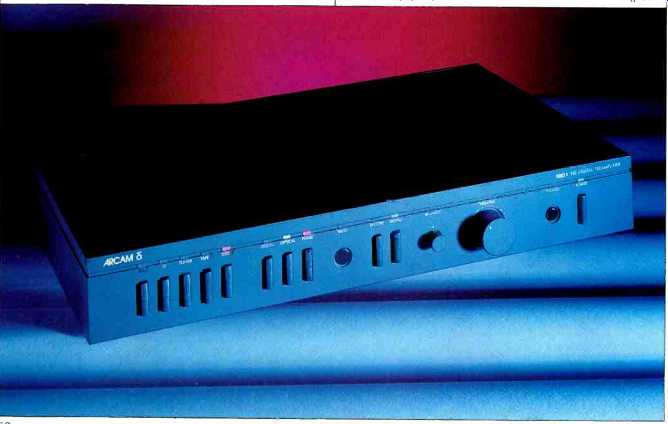
Manufacturer's Specifications:
Frequency Response: 20 Hz to 20 kHz, +0.1,-0.5 dB, via line or digital inputs.
Sensitivity: MM phono, 2 mV; MC phono, 100 uV; line level, 200 mV.
Input Impedance: MM phono, 47 kilohms; MC phono, 220 ohms; line level, 45 kilohms.
Noise (CCIR): MM phono, -64 dB; MC phono, -50 dB; line level, -89 dB; digital, -96 dB.
Nominal Output Level: Line, 2 V; tape, 0.3 V; headphone, 4 V.
Output Impedance: Line, 25 ohms; tape, 70 ohms: headphone. 200 ohms.
Minimum Recommended Output Load: 5 kilohms.
Recommended Headphone Load: 32 ohms to 2 kilohms.
Maximum Output Level: More than 8 V.
Channel Balance: 1 dB.
Crosstalk at 1 kHz: Line, below -70 dB; tape, below -65 dB.
Muting: 40 dB.
Dimensions: 17 in. W x 2 1/2 in. H x 10 1/2 in. D (43.2 cm x 6.4 cm x 26.7 cm).
Weight: 8.2 lbs. (3.7 kg).
Price: $1,500, including remote; pho no input-loading modules (see text), $35.
Company Address: c/o Audio In flux, P.O. Box 381, Highland Lakes, N.J. 07422.
It's one of those apparent quirks of fate that both the Cambridge in Cambridgeshire and its namesake in Massachusetts have been nuclei not only of learning but of technical development and design elegance. One of several audio manufacturers that might be cited as examples from the Old Country is Arcam, the brand name of A&R Cambridge.
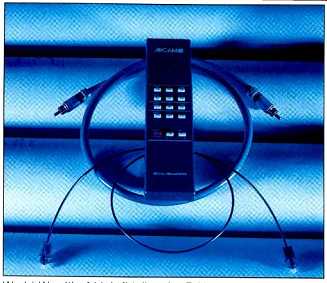
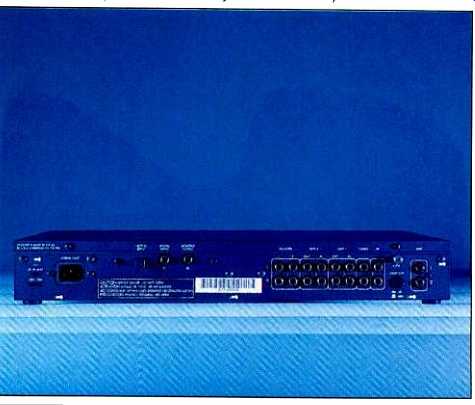
(The initials stand for amplification and recording, incidentally, not artists and repertoire.) While the companies that made the American city an audio mecca were generally founded by people associated with the first wave (post-World War II) of high fidelity, the British crowd tends to be both younger and more firmly rooted in the later solid-state and digital technologies.
In particular, Arcam and its brethren have been on the cutting edge in designing D/A converters, offering both built-ins and free-standing units that can be used with any CD player or digital recorder having a digital output. The Delta 110 preamp continues this tradition by including a D/A converter in an otherwise analog design. It also offers electronic switching, including provision for two tape decks or other outboards, controlled by a logic system that is as finely polished as it is unobtrusive.
If you admire the Delta 110's finesse but don't think you need the D/A converter (or don't yet need it), Arcam offers the Delta 110S for $400 less. The 110S dispenses with the converter and uses its coaxial input and output jacks as analog inputs for a CD player (selected at the front panel's "Digital" button). You can retrofit the D/A converter to the 110S if you later want to upgrade, but at present prices that route would cost you $100 more than going directly to the model reviewed here.
Control Layout
The front-panel selectors are all rectangular buttons with bicolor LED pilots just above them. In general, a green pilot indicates that the button has been selected, while a red one indicates a special function or its use in taping. The selectors themselves are at the left end of the panel and are marked for "Disc" (phono), "AV" (implying video use but actually functioning as an AUX input), "Tuner," "Tape 1," and "Tape 2." There is no input labeled "CD," since it is assumed you will use the D/A converter for that purpose.
The next group of buttons to the right selects the D/A converter's "Digital" and "Optical" inputs and "Phase." This last inverts the polarity of the converter's output so that, if you can tell the difference and have a preference, you can correct for presumably phase-inverted CDs. (There is no switch for phase-inverted LPs.) What looks like a round muting button to the right is actually the sensor for the supplied remote control, with the muting LED above it. The muting can only be triggered from the remote.
The "Record" button flashes its LED when you press it; during the 5S or so that it remains flashing, you can choose any input as the recording source. Once you've chosen the source, the "Record" LED goes off. If the source you've selected is not the one you're listening to, its LED will glow red, while the LED for the source you're monitoring will glow green. If the same source is chosen for both listening and recording, its LED glows green. If you then monitor the deck to check the recording, the LED for the selected deck ("Tape 1" or "Tape 2") turns green and the source's LED turns red.
During dubbing, which can be in either direction between the two sets of tape connections, the preamp's control logic prevents you from monitoring the source deck--and will, in fact, interrupt the dub if you try to do so. This is a byproduct of the logic circuitry's prohibition against choosing the same deck as recorder and source, to prevent feedback. Inability to monitor the source directly could prove somewhat onerous in some dubbing setups, but the feedback that could be the alternative could prove disastrous-to the recording, if not to amps or loudspeakers.
Next to "Record" is a toggle button for selecting mono or stereo. Moving farther to the right, we find a small rotary "Balance" control (with no detents), the "Volume" knob, the headphone jack, and finally the "Power" switch. The volume control is motor-driven by the remote but clutched so that aggressive manipulation won't burn out the motor windings via back EMF. The headphone jack is wired to disconnect the main outputs when a headphone plug is inserted.
The remote (made for Arcam in Germany, incidentally, though the preamp itself is made in the U.K.) includes all the front-panel control functions except "Balance" and "Record." The latter's absence is deliberate, to prevent accidental interruptions once recording has begun. Volume is remotely adjusted with " + " and "- " buttons, and there is a button for muting and a red one marked "Standby." The latter turns off the preamp's main outputs (but does not defeat the tape feed if any is selected) and leaves the power supplies on so that the Delta 110 will be fully warmed up whenever you turn it on.
Arcam evidently finds a sonic advantage in this, though none was confirmed in testing. In "Standby" mode, only the power LED glows on the front panel. Previous settings are restored when you press "Standby" once again. Should you misplace the remote, normal operation can be restored by turning the preamp off, and then on, with its power switch.
Most of what you'll find on the back panel is implicit in the foregoing. In addition to optical and coaxial digital inputs, there's a digital output to pass on the incoming digital bitstream, unaltered, to other equipment. The various analog input and output jacks--including two sets for the main output-are all gold-plated. Next to the pair of phono inputs (and a binding-post ground) is a phono mode switch to choose between MM operation (for moving-magnet or high output moving-coil pickups) and MC operation (for tradition al, low-output moving-coil models).
One further adjustment is not visible from the outside. If your phono pickup would be better served by an input impedance other than the fixed values provided in the Delta 110, you can buy a separate MM or MC loading module.
The module plugs into a connector beneath the preamp's top plate and incorporates a switch array to select other impedance values. Unless you have an oddball cartridge, there's no reason to suppose that adding a module would effect an improvement; the tested unit did not have one.
Measurements
Diversified Science Laboratories' measurements generally confirmed-within reasonable tolerance, once differences in test method are accounted for--Arcam's claims for the Delta 110. Two quibbles are raised by the data in Table I.
The main output impedance measures twice as high as the manufacturer's specification, though not high enough to be of concern. And the muting is even greater than the claim of 40 dB. This too is of little real importance; however, if you're used to the almost universal 20 dB of attenuation, the near inaudibility of the muted output at moderate volume settings may make you forget to turn the muting back off.
One other point may be of concern if you plan to use the Delta 110 with components that deliver exceptionally high signal levels. The input overload points are not particularly generous, though they should be more than acceptable with normal equipment. With any preamp, it is always best to adjust any output level controls on your source components for parity with the levels delivered by your other sources; the Delta 110's design simply makes this consideration slightly more urgent than usual.
The balance control's lack of a detent leaves its centering slightly equivocal, but the unusually gentle action of the Delta 110 in this regard-its maximum attenuation at either extreme is only about 10 dB--means that small rotations make only tiny sonic differences. The 0.3 dB of measured channel imbalance is well within the spec and certainly of no great concern. Anyway, channel balance is best adjusted by ear for the acoustic properties of the listening room, whatever the measurement may say.
Figure 1 shows overall analog frequency response.
Again, it is well within the spec and is, in fact, flat within a tiny fraction of 1 dB from 10 Hz to 10 kHz. The ultrasonic roll off only makes very small demands (less than the specified 0.5 dB) within the audio range. The frequency response through the D/A converter (Fig. 2--which, unlike Fig. 1, is limited to the audio band) is very similar, with only minor ripples at the highest frequencies.

Fig. 1--Frequency response through the Tuner" input at an output level of
500 mV.
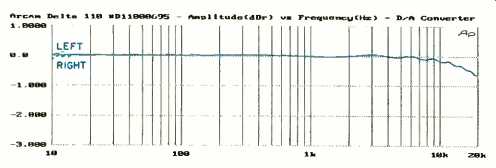
Fig. 2--Frequency response through the D A converter, with gain set for 2 V
out from 0-dB signals.
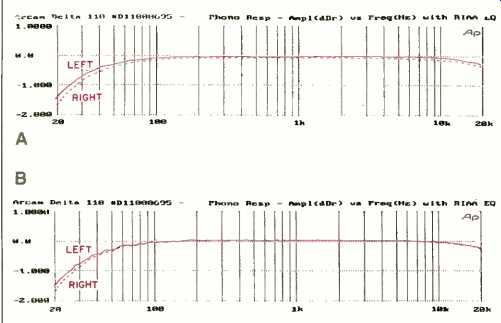
Fig. 3--Phono frequency response (RIAA accuracy) through MM input with gain
set to 40 dB at 1 kHz (A) and through MC input with gain set to 60 dB at
1 kHz (B).
Figure 3 shows phono frequency response. The curves for MC cartridges (Fig. 3B) are, if anything, even marginally flatter than those for MM cartridges (Fig. 3A). The bass roll-off to attenuate spurious warp "information" in the near-infrasonic range is virtually universal these days; the extreme flatness elsewhere in these curves is harder to find in competing products.
Figure 4A, showing THD + N at three frequencies, gave us pause when we first saw it. Wherever possible (and appropriate), Diversified Science Labs follows the EIA/IHF measurement standard, which demands that testing conditions be as near to those in the real world as possible. For most measurements, the stipulations result in a volume setting that delivers a 0-dB gain (out of a possible 20.1 dB)-and, not incidentally, puts the volume control near the 9-o'clock position, which was used for most of the listening tests. For distortion measurements, however, volume is raised to yield a 12-dB gain. At this setting, the THD + N curves are all well within spec. Moreover, they demonstrate that distortion should be in the range from 0.001% to 0.003% for all typical peak signal levels-in other words, of no consequence whatever. But why do the curves start to take off near 2.5 V and "think better of it" above 3 V before finally hitting their limit above 9 V? In looking at the actual distortion products involved, we could see that, at low levels, distortion is predominantly second harmonic. The increase in distortion just below 3 V was occasioned by a rise in the proportion of third harmonic, until it dominated the harmonic content. Clipping only begins above 9 V, as you would expect. It soon became apparent, however, that the amplitude of this increase in the third harmonic was dependent on the gain setting.
Figure 4B shows results for THD + N with the volume control wide open, for the full 20.1-dB gain. The noise level is higher (the downward sloping curves) because of the higher setting, but the anomaly above 2.5 V has entirely disappeared! The gradual rise in the 20-kHz curve at higher levels is attributable to slew-rate limiting but is of no consequence; any signal that delivers 20 kHz at this level must be considered abuse--of your tweeters, if nothing else.
So we know that the phenomenon is one that would not show up at all in full-gain testing (which is not uncommon), and presumably it is caused by distortion in the input stage.
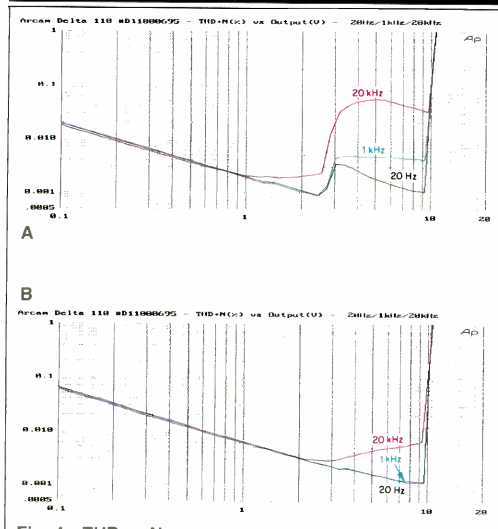
Fig. 4--THD + N vs. output voltage through the "Tuner" input, with
gain set to 12 dB (A) and to maximum (B); see text.
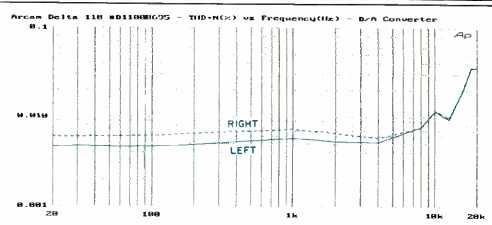
Fig. 5--THD + N vs. frequency through D A converter, with output level set
to 2 V.
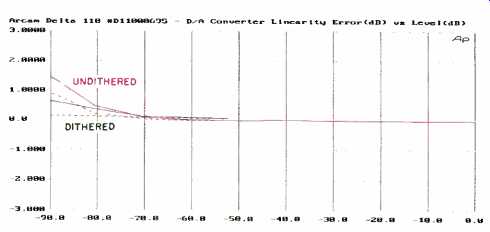
Fig. 6--Linearity error vs. level at 997 Hz, for dithered and undithered signals.
Left channel shown by solid curve, right channel by dashed curve.
No rational use of the preamp would call for leaving the volume control at maximum, and the anomaly should not be audible even at normal volume settings. It is merely a testing curiosity.
The THD + N curves in Fig. 5 were made through the D/A converter with output set to 2 V. There is some distortion increase in the ultra-highs, as you might expect from Fig. 4, but again it is too low to be of consequence. The linearity curves of Fig. 6, with the curves for dithered signals super imposed on those for undithered signals, are excellent. As signal level drops, distortion becomes an increasingly greater percentage of the decreasing signal, producing the characteristic increase in nonlinearity as the signal level approaches the limit of the 16-bit medium's resolving power. This increase, however, is ameliorated by the use of dithering. Absolute values of the distortion products actually are highest at maximum signal levels but remain about 84 dB (worst case) below a 0-dB signal at 1 kHz (actually, 997 Hz) in the measurements.
----------
Table I--Miscellaneous test data.
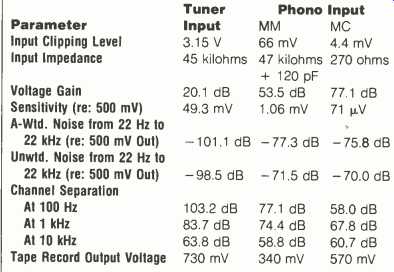
- Maximum Output Level: Main, 10.4 V; headphone, open circuit, 9.3 V; headphone, into 50 ohms (27.8 mW), 1.18 V.
- Output Impedance: Main, 50 ohms; tape, 75 ohms; headphone, 185 ohms.
- Muting: 48.3 dB.
Notes:
1. Measurements made on one channel were made on the left channel.
2. With the exception of gain and sensitivity (which were measured with maximum gain and no load on the preamp), volume was set in accordance with the IHF/EIA Standard and outputs were terminated in 10 kilohms plus 1,000 pF.
3. From the "Tuner" input, with balance centered and volume set per IHF/EIA Standards, the right channel's output was 0.3 dB greater than the left channel's.
--------------
Use and Listening Tests
Using the Delta 110 was an unalloyed joy. Its design is handsome, logical, and sonically pure. Beyond that, there really is little that need be said.
Naturally, the focus of the listening was on the D/A converter, as the most unusual element in the preamp. The CDs that I always test with, because they can sound a mite harsh or strident on some players, were as well behaved here as I've ever heard them. Those with more ingratiating sonics stood to profit less, but they frequently revealed small felicities that had not been apparent before. Simply put, this D/A converter is among the best I've heard.
With my equipment, signals passing through the converter sounded, subjectively, somewhat lower than those from the tuner or tape deck. However, only a minor level adjustment, if any, was required to rectify this. And, of course, the remote makes the adjustment easier with the Delta 110 than it is with most audiophile-class preamps.
Incidentally, the tape outputs on the reviewed sample remained live even in "Standby" mode, despite the contrary implication of the manual, so you can record from a timer (assuming your deck can handle it) without turning on the preamp. From the measurement of tape output impedance, it's evident that the outputs are buffered, which prevents ancillary equipment from loading down the listening path.
Therefore, more than just the power supplies appear to remain active in "Standby." Available information about the internal workings of the Delta 110 was rather sparse. For testing purposes, this is possibly a good thing; fiery descriptions of arcane circuitry can prove to be more of a smoke screen than a source of illumination. And in the end, it is the results that matter, not the means by which they are achieved. The results in this case are extremely gratifying.
-Robert Long with Edward J. Foster
[ Adapted from Audio magazine/Jun. 1992]
Also see:
Rotel RC-870 Preamp (Aug. 1985)
Amber Model 7 Tuner and Model 50b Amplifier (Aug. 1985)
Anthem Pre-1 Preamplifier (April 1997)
= = = =